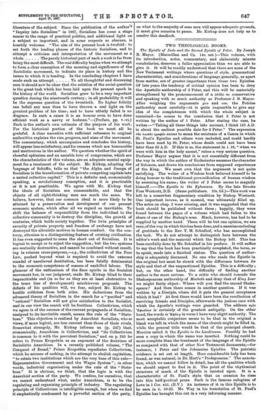TWO THEOLOGICAL BOOKS..
The Epistle of Jude and the Second Epistle of Peter. By Joseph B. Mayor. (Macmillan and Co. 14s. net.)—This volume, with its introduction, notes, commentary, and elaborately minute vocabularies, deserves a fuller appreciation than we are able to give it. It will be readily understood that there are none of the New Testament writings where questions of style, grammatical characteristics, and considerations of language generally, as apart from matter, are of greater importance than these two Epistles. Of late years the tendency of critical opinion has been to deny the Apostolic authorship of 2 Peter, and this will be materially strengthened by the pronouncement of a critic so conservative and speaking with so much authority as Professor J. B. Mayor. After weighing the arguments pro and con, the Petrine authorship most carefully—it is quite impossible to give any idea of the completeness with which the whole subject is examined—he comes to the conclusion that 2 Peter is not written by the author of 1 Peter. After stating the case, he writes :—" Taking all these things into account, I think 125 A.D. is about the earliest possible date for 2 Peter." The expression ray mares weepar seems to mean the existence of a Canon in which St. Paul's Epistles and others were included, and could hardly have been used by St. Peter, whose death could not have been later than 65 A.D. If this is so, the statement in i. 18, "when we were with him in the holy mount," raises a very serious question. Professor Mayor argues that it is not essentially different from the way in which the author of Ecclesiastes assumes the character of Solomon, and draws his conclusions from supposed experiences of the King. We must own that the argument is not quite satisfying. The writer of a Wisdom book believed himself to be doing honour to the traditional personification of human wisdom by assuming his name ; the writer of 2 Peter seems to magnify himself.—The Epistle to the Ephesians. By the late Brooke Foss Westcott, D.D. (Same publishers. 10s. 6d.)—This work was left in a somewhat fragmentary condition by Bishop Westeott. One important lacuna, as it seemed, was ultimately filled up. The notes on chap. 2 were missing, and it was suggested that the book should be published without them ; happily, they were found between the pages of a volume which had fallen to the share of one of the Bishop's sons. Much, however, has had to be supplied by another hand. There will be but one opinion, we are sure, of the way in which this has been done, and a unanimous feeling of gratitude to the Rev. T. M. Schulhof, who has accomplished the task. We do not attempt to distinguish here between the editor's work and the material which the Bishop left. This has been carefully done by Mr. Schulhof in his preface. It will suffice to say that the book has been practically completed, the torso, so to speak, made into a finished statue. The question of author- ship is adequately discussed. No one who reads the Epistle in the original but must be struck with the difference between its style and that of the unquestioned Epistles. This is a difficulty ; but, on the other hand, the difficulty of finding another author is far more serious. To a critic who should Concede the Shakespearean authorship of Macbeth and deny that of King Lear we might fairly object : Where will you find the second Shake- speare? And then there comes in another question. If it was written by a Disciple, where did it gain the general acceptance which it had ? At first there would have been the recollection of surviving friends and Disciples, afterwards the jealous care with which the Apostle's writings were guarded. The address grpbs Topeotovs is certainly of the greatest antiquity. On the other hand, the words ?r 'Eeke in verse 1 have very slight authority. The most acceptable conjecture seems to be that in the original a blank was left in which the name of the church might be filled in, while the general title would be that of the principal church. Marcion called it the Epistle to the Laocliceans. Possibly he had seen a copy in which the name was inserted. Nothing could be more complete than the treatment of the language of the Epistle as compared with that of other New Testament documents,—for instance, 1 Peter and the Johannine Epistles. The patristic evidence is set out at length. Here considerable help has been found, as was natural, in Dr. Hort's "Prolegomena." The annota- tion, which we cannot follow in detail, has all the qualities which we should expect to find in A. The point of the rhythmical structure of much of the Epistle is insisted upon. It is characteristic of St. Paul's style that on occasion he rises into this half-poetical prose. Such is the famous euloginm of Love in 1 Cor. xiii. (RN.) An instance of it in this Epistle is to be seen in ii. 19-22. Mr. Way in his translation of St. Paul's Epistles has brought this out in a very informing manner.


























































 Previous page
Previous page